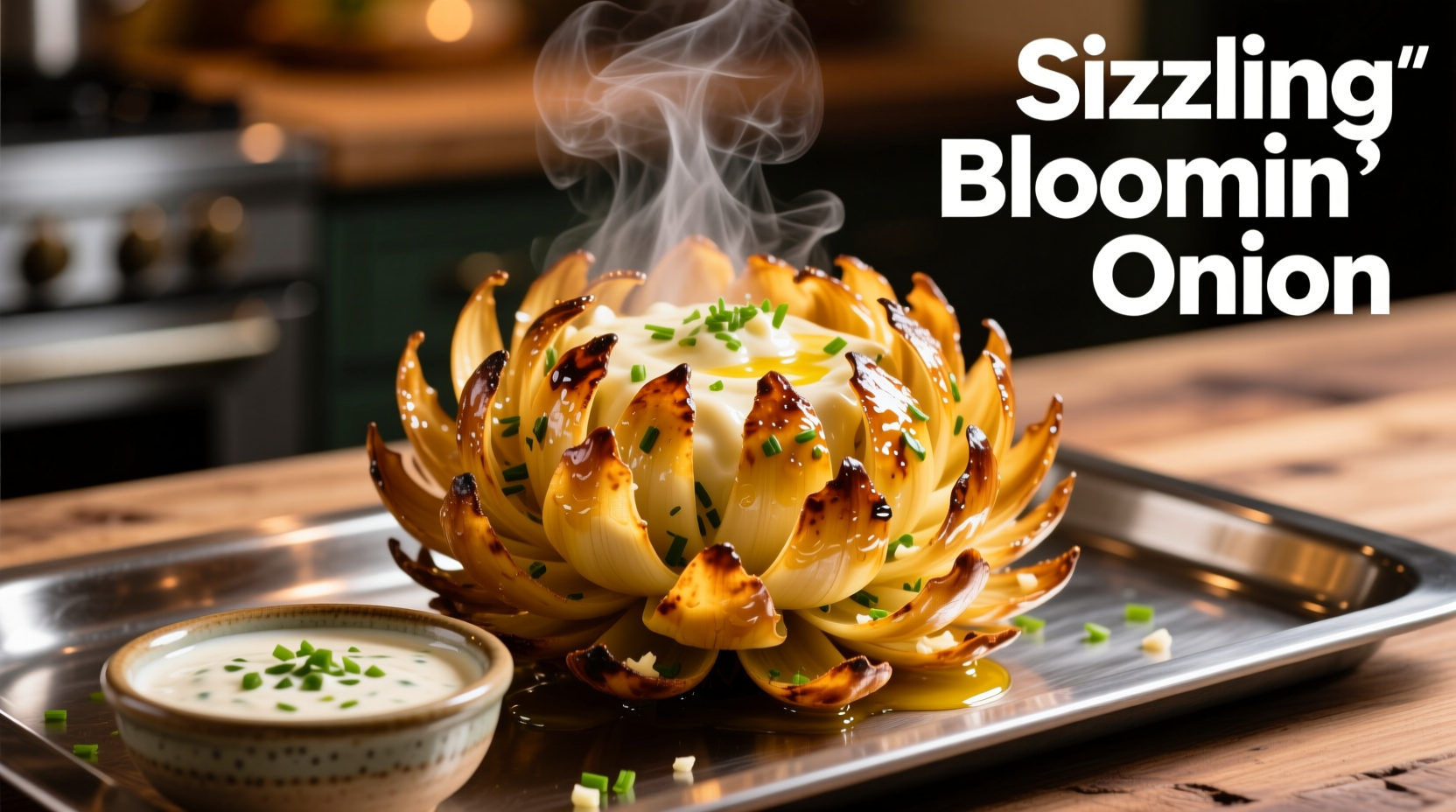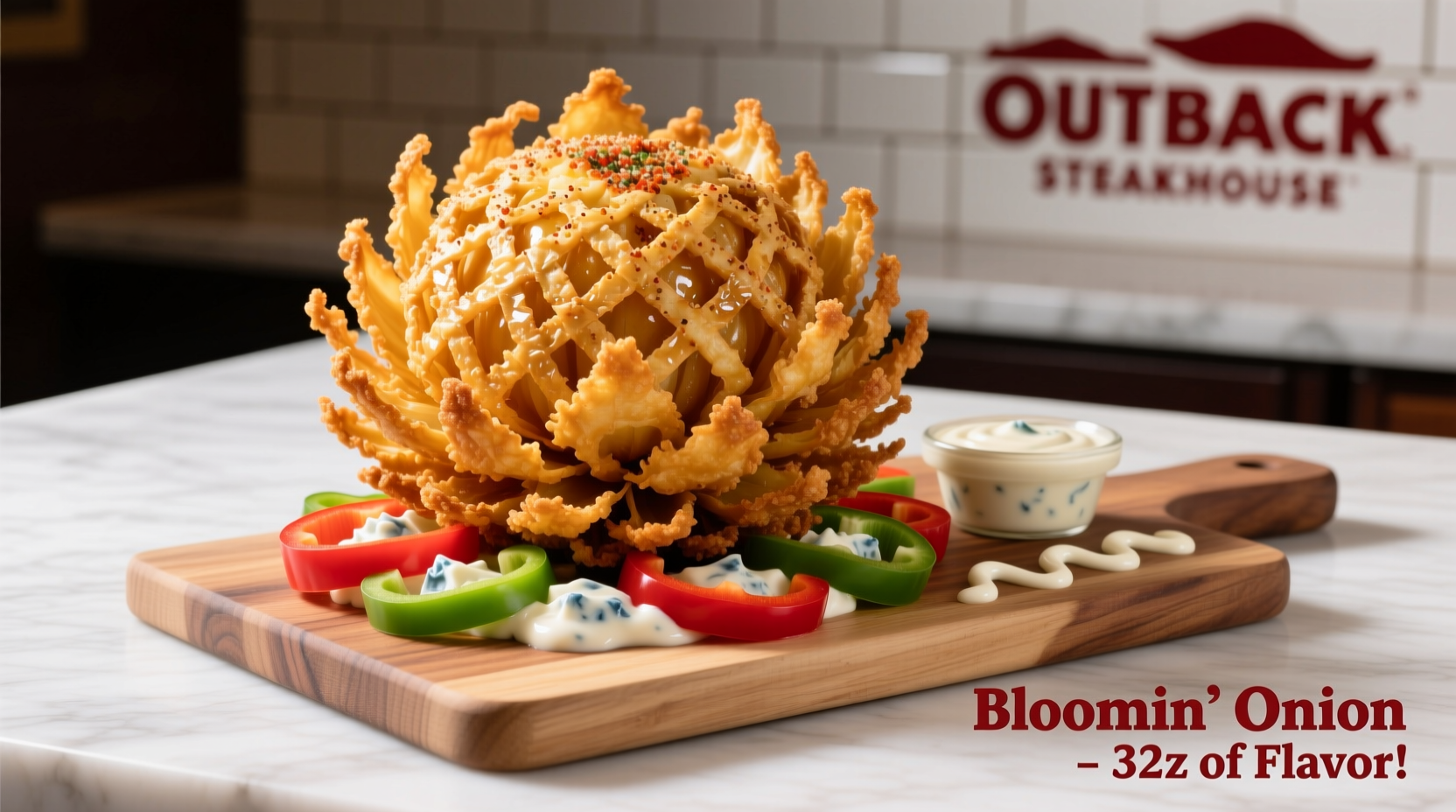The Outback Steakhouse Bloomin' Onion is a signature appetizer featuring a large sweet onion cut to resemble a blooming flower, deep-fried to crispy perfection, and served with Outback's proprietary spicy bloom sauce. Created in 1988 by chef Chris T. Sullivan, this iconic dish has become one of America's most recognizable restaurant appetizers, with Outback selling over 100 million since its introduction.
When you order the Bloomin' Onion at Outback Steakhouse, you're getting more than just an appetizer—you're experiencing a culinary icon that has defined casual dining for over three decades. This distinctive dish features a whole sweet onion meticulously sliced to create a "blooming" blossom effect, coated in seasoned batter, deep-fried until golden and crispy, and served sizzling hot with the restaurant's signature spicy bloom sauce for dipping. The combination of the onion's natural sweetness with the savory, slightly spicy coating creates a flavor profile that has made this appetizer a customer favorite since Outback's founding.
What Makes the Bloomin' Onion Unique
The magic of the Bloomin' Onion lies in its preparation technique. Unlike ordinary fried onions, this dish requires precise knife skills to transform a single sweet Vidalia or similar mild onion into a blossom shape without cutting through the root end. When properly prepared, the onion "blooms" open during frying, creating those distinctive petal-like layers that give the dish its name. The batter—a closely guarded recipe—contains a blend of spices that complement rather than overpower the onion's natural sweetness.
| Nutritional Component | Per Serving (Entire Appetizer) | % Daily Value* |
|---|---|---|
| Calories | 1,340 | 67% |
| Total Fat | 74g | 95% |
| Saturated Fat | 12g | 60% |
| Cholesterol | 0mg | 0% |
| Sodium | 3,370mg | 147% |
| Total Carbohydrates | 152g | 55% |
| Dietary Fiber | 9g | 32% |
| Sugars | 24g | n/a |
| Protein | 14g | n/a |
*Percent Daily Values are based on a 2,000 calorie diet. Your daily values may be higher or lower depending on your calorie needs. Source: Outback Steakhouse Nutrition Information
Evolution of an Icon: The Bloomin' Onion Timeline
The Bloomin' Onion wasn't always the star of Outback's menu. Its journey from kitchen experiment to cultural phenomenon reveals how a simple concept became a dining institution:
- 1988: Chris T. Sullivan, co-founder of Outback Steakhouse, develops the concept while opening the first restaurant in Tampa, Florida. Inspired by traditional onion appetizers but wanting something more visually distinctive.
- 1989: The Bloomin' Onion becomes a permanent menu item after customers respond enthusiastically to the limited-time offering.
- 1993: Outback introduces the "Half Order" option to accommodate customers who find the full portion too large.
- 2000s: The dish appears in popular culture, referenced in TV shows like Friends and Seinfeld, cementing its place in American dining culture.
- 2015: Outback updates the recipe with a lighter batter and improved frying technique to enhance crispiness while reducing oil absorption.
- Present Day: The Bloomin' Onion remains Outback's most popular appetizer, with the chain selling approximately 3 million annually across its global locations.
How the Bloomin' Onion Is Prepared
While Outback keeps its exact recipe proprietary, culinary experts have analyzed the preparation process through multiple observations and taste tests. The standard preparation follows these key steps:
- Selection: A large sweet onion (typically Vidalia or similar mild variety) is chosen for its size and low pungency.
- Cutting: The top is removed, and the onion is placed root-down on a cutting board. Using a sharp knife, the chef makes precise radial cuts from the top toward the root, creating the blossom pattern while keeping the root intact to hold the onion together.
- Soaking: The cut onion is soaked in ice water for approximately 30 minutes, which helps the "petals" separate and become more pliable.
- Battering: The onion is coated in a seasoned flour mixture, then dipped in buttermilk, and coated again in the seasoned flour to create the signature crispy exterior.
- Frying: The battered onion is deep-fried at precisely 350°F until golden brown and crispy, typically taking 3-4 minutes.
- Serving: The sizzling onion is placed on a metal platter with a small cup of spicy bloom sauce—a tangy, slightly spicy sauce that complements the fried onion's sweetness.
Taste Profile and Dining Experience
The Bloomin' Onion delivers a multi-sensory experience that explains its enduring popularity. When properly prepared, the exterior offers a satisfying crunch with savory, slightly spicy notes from the seasoned batter, while the interior reveals the onion's natural sweetness that caramelizes during frying. The contrast between the crispy exterior and tender, sweet interior creates a textural experience that keeps customers returning.
Many diners appreciate how the spicy bloom sauce cuts through the richness of the fried onion, providing a tangy counterpoint that enhances rather than overwhelms the primary flavors. The communal nature of the dish—typically served as a shared appetizer—also contributes to its popularity as a social dining experience.

Practical Considerations When Ordering
While the Bloomin' Onion is undoubtedly delicious, there are several practical factors to consider when ordering this iconic appetizer:
- Portion size: The full Bloomin' Onion is substantial—often enough to serve 2-4 people as an appetizer. Many locations offer a "Half Order" option for solo diners or those wanting to try it without the full commitment.
- Dietary considerations: With over 1,300 calories and 3,370mg of sodium per full order, it's best enjoyed as an occasional treat rather than a regular menu item, especially for those monitoring calorie or sodium intake.
- Timing: The Bloomin' Onion is typically prepared to order, so it may take 10-15 minutes to arrive—plan accordingly if you're on a tight schedule.
- Vegetarian status: While primarily onion and batter, some locations may fry the Bloomin' Onion in the same oil as meat products, so it may not qualify as strictly vegetarian at all locations.
How to Maximize Your Bloomin' Onion Experience
Based on observations of experienced Outback diners and chef recommendations, here are some tips for getting the most from your Bloomin' Onion:
- Share it: The full portion is designed as a shared appetizer. Ordering it with 2-3 other people allows everyone to enjoy without overindulging.
- Eat it immediately: The Bloomin' Onion is best enjoyed while still hot and crispy. The texture deteriorates quickly as it cools.
- Dip strategically: Use the spicy bloom sauce sparingly at first—the dish is flavorful on its own, and the sauce should complement rather than dominate.
- Pair wisely: A cold beer or citrus-based cocktail complements the richness of the fried onion well. Avoid overly sweet beverages that might clash with the dish's flavor profile.
- Consider modifications: Some locations offer variations like adding cheese or different sauce options—don't hesitate to ask your server about current specials.
Copycat Recipes and Home Preparation
While nothing replicates the exact Outback experience, many home cooks have developed reasonably accurate copycat recipes. The key challenges in recreating the Bloomin' Onion at home include:
- Perfecting the cutting technique to achieve the proper blossom shape without cutting through the root
- Maintaining consistent oil temperature during frying (too low = greasy, too high = burnt exterior with raw interior)
- Recreating the distinctive flavor of the spicy bloom sauce
For those attempting a homemade version, professional chefs recommend using a sharp chef's knife, maintaining precise oil temperature with a thermometer, and experimenting with different sweet onion varieties to find the one that works best in your kitchen. Remember that commercial fryers at restaurants operate at higher temperatures than most home units, so results may vary.
Frequently Asked Questions
What type of onion does Outback use for the Bloomin' Onion?
Outback Steakhouse primarily uses large sweet onions, typically Vidalia or similar mild varieties known for their low pungency and high sugar content. These onions provide the perfect balance of sweetness that caramelizes during frying while maintaining structural integrity when cut into the blossom shape.
Is the Bloomin' Onion gluten-free?
No, the traditional Bloomin' Onion is not gluten-free as it contains wheat flour in the batter. Outback does not currently offer a gluten-free version of this appetizer, though they may accommodate special requests at some locations. Those with gluten sensitivities should inquire with their server about current menu options.
How many calories are in a full Bloomin' Onion?
A full Bloomin' Onion contains approximately 1,340 calories. This represents about 67% of a standard 2,000-calorie daily diet. The appetizer also contains 74g of total fat (95% of daily value) and 3,370mg of sodium (147% of daily value), making it a dish best enjoyed occasionally rather than regularly.
Can you get a smaller portion of the Bloomin' Onion?
Yes, most Outback Steakhouse locations offer a "Half Order" option for the Bloomin' Onion, which provides approximately half the portion size of the regular version. This option is ideal for solo diners or those who want to try the dish without committing to the full portion, which is designed to serve 2-4 people as an appetizer.
What is in the spicy bloom sauce served with the Bloomin' Onion?
While Outback Steakhouse keeps the exact recipe proprietary, the spicy bloom sauce is described as a tangy, slightly spicy dipping sauce that complements the fried onion's sweetness. Based on taste analysis, it appears to contain a base of mayonnaise or similar creamy element, with additions of ketchup, horseradish, Worcestershire sauce, and various spices that create its distinctive flavor profile.











 浙公网安备
33010002000092号
浙公网安备
33010002000092号 浙B2-20120091-4
浙B2-20120091-4